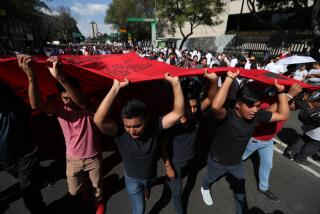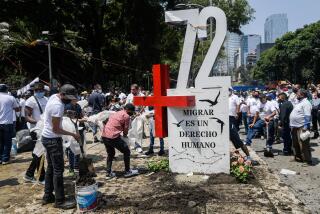Guatemalan Regime Blamed for War Atrocities
GUATEMALA CITY — The government allowed the army to carry out a policy of genocide against Maya Indians during the bloodiest era of Guatemala’s 35-year civil war, a U.N. commission declared Thursday.
As a standing-room-only crowd wept and cheered, the Commission for Historical Clarification presented a report that found the government responsible for a stunning 93% of the 42,275 human rights violations that the panel investigated during 18 months of interviews and other research.
The country’s Marxist guerrillas committed 3% of the violations, and responsibility for another 4% could not be determined, according to the 3,600-page report, “Memory of Silence.”
More than 200,000 people, mostly civilians, died or disappeared during the conflict that ended with a peace agreement in December 1996. The United States, Cuba and U.S. companies in Guatemala also played direct roles in prolonging the fighting, the commission found.
The commission, which was created by the peace accord, had been considered largely toothless because it was forbidden to identify individuals responsible for crimes and was powerless to bring anyone to trial.
The panel compensated by laying blame for atrocities squarely on the government and recommending investigations that would lead to a purge of the current military hierarchy and reform the army and police force.
At Thursday’s presentation, the crowd that spilled over into the halls and foyers of the modernistic National Theater--ranging from men in suits to women in the colorful traditional dress of Maya Indians--did not hesitate to attach names to the crimes.
“Efrain Rios Montt, just like Pinochet,” they shouted, equating the military dictator who presided over a “scorched-earth” policy from 1982-83 with former Chilean dictator Augusto Pinochet, who is now fighting extradition from Britain to Spain for human rights abuses during his rule.
The report found that 83% of the victims were Maya Indians and that more than half the 626 massacres committed were carried out in a single province, El Quiche. One Maya ethnic group, the Ixil, lost 70% to 90% of its villages.
The government, which assumed that the Maya supported the guerrillas, considered the Indians an “internal enemy,” according to the report.
“Agents of the Guatemalan government, in the framework of a counterinsurgency effort during the years 1981 to 1983, carried out acts of genocide against groups of the Mayan people,” said the commission’s leader, Christian Tomuschat.
The government must have been aware of the policy because presidents during that period were all high-ranking military officers, the report noted. In addition, the government failed to investigate and punish those acts of genocide, the report found.
As President Alvaro Arzu watched stone-faced from the first row of spectators at the theater, Tomuschat said: “The excuses that lower-ranking soldiers acted with wide autonomy, explaining that excesses and errors were committed that were not ordered by superiors, are baseless arguments based on our investigation.”
Arzu, who took office in January 1996, recently offered such explanations.
“Both the government and the [former guerrillas] should recognize that the report is true and ask forgiveness of the entire nation,” Tomuschat said.
The terror that pervaded Guatemalan society during the conflict was the product not just of war, but also of social and economic stratification and outright racism, along with the government’s refusal to change, the report found.
“Up until the mid-1980s, there was strong pressure from the U.S. government and U.S. companies to maintain the country’s archaic and unjust economic structure,” Tomuschat said.
Washington has repeatedly denied any role in Guatemala’s civil war, and U.S. Ambassador Donald J. Planty reiterated that denial Thursday.
The report also found that Cuba had trained guerrilla troops, but the panel was unable to confirm participation by other countries.
Leftist Salvadoran guerrillas and the leftist Sandinista government in Nicaragua are widely believed to have cooperated with Guatemala’s insurgents in the 1980s.
Nearly half the report’s recommendations were directed at reforming the military and police to create forces that are clearly subject to civilian control.
Defense Minister Hector Barrios Celada was not available for comment, and no one else was authorized to respond to the report, according to an army public relations employee.
After three decades of equating silence with survival, Guatemalans finally began to talk in the wake of the 1996 accord.
However, the nation was horrified in April when a prominent bishop was killed just two days after he issued an extensive report detailing numerous human rights violations by the military during the war. His death provoked a furor and sparked widespread suspicions that the military was involved in the killing.
Many in the crowd Thursday cried while others cheered as Tomuschat read a recommendation that the government excavate the hundreds of clandestine mass graves and actively try to find the thousands of people still missing.
“All that they have said is true,” said Rosa Tuiz, 24, whose two uncles were kidnapped from their village of San Pedro Yepucapo in the highland province of Chimaltenango in 1982. “They raped, they murdered, they burned our villages.
“Now it is time for the government to take responsibility for its violations, for the widows and orphans it caused,” Tuiz said.
More to Read
Sign up for Essential California
The most important California stories and recommendations in your inbox every morning.
You may occasionally receive promotional content from the Los Angeles Times.










